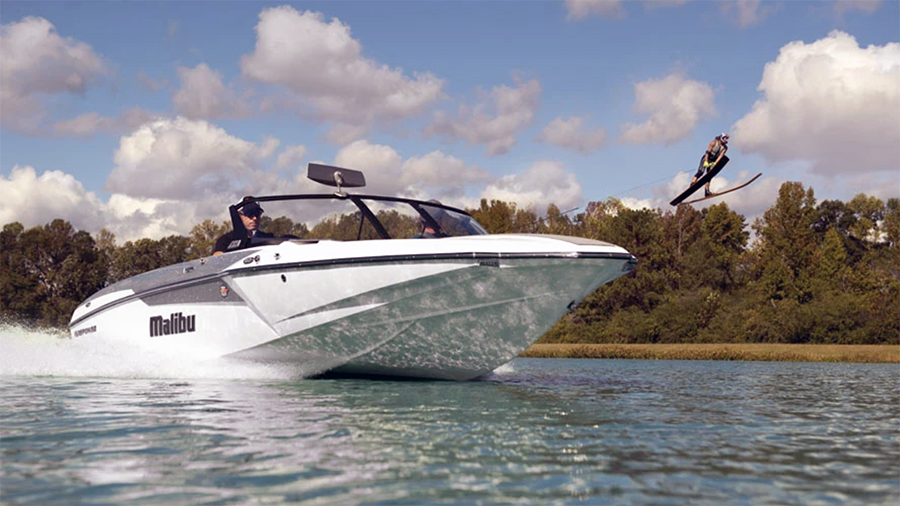The National Marine Manufacturers Association (NMMA), the trade association helmed by former OIA CEO Frank Hugelmeyer, representing approximately 85 percent of the U.S. market for recreational boat, marine engine, and accessory manufacturers, is reporting total new powerboat retail unit sales in 2024 declined an estimated 9 percent to 12 percent, to ~230,000 to 240,000 units in the U.S. market.
“Throughout 2024, the industry continued to normalize following record demand during the COVID pandemic while navigating persistent inflationary pressures and rising interest rates,” NMMA said in a summary of its annual assessment of the business.
Looking to 2025, NMMA said it anticipates sales of new powerboats to begin to show signs of a return to growth, driven by innovative new products, changes in U.S. economic policies and consistent consumer demand for on-water experiences.
“With Americans continuing to hit the water in record numbers since 2020, U.S. boating expenditures in 2025 are expected to sustain those record highs and come in as much as 3 percent to 5 percent above 2024’s anticipated final tally of $55 billion,” the trade association suggested.
In terms of boat sales trends, new freshwater fishing boats, one of the largest boat segments in volume, reportedly held steady in 2024, according to NMMA figures, and are expected to end the year flat compared to 2023 at ~51,000 to 54,000 new units sold.
The other two volume leaders in 2024 were said to be new personal watercraft and new pontoon boats, estimated to see ~70,000 to 75,000 and ~52,000 to 55,000 new unit sales, respectively, with expected declines between 10 percent and 13 percent in 2024.
“In addition to providing a versatile experience, these categories often represent a lower comparable price point and ease of use as they are typically towed to local waterways, signaling continued demand for boating among value-seeking buyers,” NMMA said.
Innovation Continues Driving Demand
As the industry navigates its growth path, NMMA said there is a sustained focus on continued innovation. With boat shows being the place to see the latest technologies and new product launches available for consumers to buy, the group said this year’s shows will highlight new ways to experience boating, making it more accessible to more people. From autonomous docking systems built with increasingly advanced AI that make navigating a boat easier to an array of diverse propulsion systems powered by everything from low-carbon fuels to hybrid systems that make boating increasingly sustainable, to boat clubs, boat sharing apps and rental platforms—the theme from boating industry in 2025 is accessibility.
“As a uniquely American-made industry with 95 percent of boats sold in the U.S. having been made in the U.S., a focus on innovation by these American companies has provided a foundation for the growth of recreational boating throughout history, both in the U.S. and around the world. This year is no different as we’ve seen marine manufacturers and businesses continue to test a wide variety of technologies and boating experiences to support consumers’ passion for enjoying the water,” said Hugelmeyer. “Trends in consumer preferences for flexibility, on-demand experiences, and easy-to-use technology—to name a few—have helped give rise to new ways to get on the water, making boating more accessible and versatile than ever.”
New Boat Sales as Economic Barometer
“Recreational boat sales, often a discretionary purchase, can act as a barometer for the economy, especially since most U.S. boat buyers (an estimated 61 percent) have an annual household income of $100,000 or less,” noted Hugelmeyer. “Some of the key economic conditions that new recreational boat sales rely on include strong consumer confidence and spending power, affordable credit, and robust access to our waterways. With stable conditions in those areas, a healthy global supply chain, and the continued ability for marine manufacturers to bring a variety of technologies and products to market, we would expect new boat sales to remain stable in the year ahead,” he continued.
The industry’s boat shows kicking off this month are one of its most important selling seasons. With hundreds of boat retailers displaying the latest products from top brands in one place, these events put the consumer in the driver’s seat, generating as much as 60 percent of annual industry sales.
One of the largest boat shows, the Discover Boating Miami International Boat Show, owned by the NMMA, brings in consumers from around the world, and is expected to attract 100,000 in February.
As shows take place nationwide, of the Top 20 boating states, the majority saw growth in boating expenditures in 2023, a trend line expected to continue and hit the $55 billion mark as 2024 data is finalized. This interest comes as Americans remain focused on their wellness, from taking to the water to connect with friends and family to enjoying the freedom and outdoor adventure boating provides.
U.S. Recreational Boating by the Numbers
- Boating and fishing are the leading drivers of the $1.2 trillion outdoor recreation economy, contributing 2.3 percent of the nation’s GDP. (Source: Bureau of Economic Analysis)
- The recreational boating industry is an economic driver supporting over 812,000 jobs in the U.S. and over 36,000 American businesses. (Source: NMMA Economic Impact Study)
- Recreational boating is a uniquely American-made industry, with 95 percent of boats sold in the U.S. made in America.
- An estimated 85 million Americans go boating every year.
- 61 percent of boaters have an annual household income of $100,000 or less.
- 95 percent of boats on the water in the U.S. are less than 26 feet in length—boats are trailerable by a vehicle to local waterways.
The Top 10 U.S. States in 2023
Leading the nation in sales of new powerboats, engines, trailers, and accessories in 2023 were the following states:
- Florida: $6.4 billion, up 3.1 percent from 2022
- Texas: $2.4 billion, down 1.4 percent from 2022
- Michigan: $1.6 billion, down 2.9 percent from 2022
- North Carolina: $1.38 billion, up 1.1 percent from 2022
- Minnesota: $1.2 billion, down 3.5 percent from 2022
- New York: $1.19 billion, down 1.7 percent from 2022
- Wisconsin: $1 billion, down 1.8 percent from 2022
- Georgia: $1 billion, up 1.2 percent from 2022
- California: $1 billion, down 3.9 percent from 2022
- Alabama: $991 million, up 2.8 percent from 2022
Data and rankings courtesy NMMA














